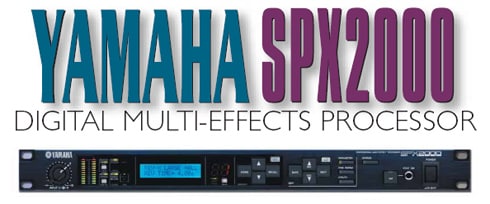SPX2000 Digital Multi-Effects Processor (Audio Media, October 2003)
  Hands up those of you who have heard of the SPX90? 900? How about the 1000? Everyone? Good. Now, please welcome the SPX2000, the latest release from Yamaha's ever-popular SPX range of professional multi-effects processors. The front panel of the SPX2000 is very nearly identical to its predecessors with a few changes and additions (like an additional 'cross-key' set for editing parameters) but nothing that isn't instantly obvious. First things first – there are three banks to the SPX2000 memory: Preset, Classic, and User. The preset bank contains 97 programs of which 17 are made with Yamaha's new REV-X reverb algorithms. Reverb Reloaded According to Yamaha, this is "the whole new generation of Yamaha Reverb programs with the richest reverberation tone and smoothest decay." There are three algorithms, REV-X Hall, REV-X Room, and REV-X Plate, which make up the 17 new presets. New features include the Room Size and Decay envelopes, giving the user finer and tighter control when creating reverbs. For those of you who like to have all your parameter control coming from and going to your computer, you're surely going to love the SPX2000's "computer-based editor program" for Mac OSX and Windows. It will be available for download from Yamaha's website in December. Couple all this with 96kHz audio DSP with 32-bit internal processing, 24-bit 128-times oversampling AD/DA converters that deliver 106dB dynamic range with a flat frequency response from 20Hz to 40kHz (at 96kHz) sampling rate and you have one hell of a powerful, clean sounding beast at your fingertips. Apparently, it all ties in nicely with Yamaha's DM Series of digital production consoles as well. Front and Back Audio connector-wise, the unit has both XLR (balanced) and quarter-inch jack connectors for left and right input and output, with a selector switch for +4dBu and -10dBu, respectively. Digital connection comes from AES/EBU XLR I/O connectors and a BNC-type Wordclock In connector. You'll also find MIDI In/Out and Thru as well as USB To Host for connection, remote control, and data management via your computer, digital console, or MIDI device. It's everything we want connectivity-wise. On the front panel, first up is the input level control consisting of two 'rings' acting either as a sole stereo input control or individually for left and right input adjustment, if needed. The 12-step level meters can be switched between input and output using one of the two buttons to the left of the meters. The other button is a mono/stereo input selector (the mono feed being taken from the left-hand side input connectors on the rear panel). Next to these buttons are the input source (analog or digital), clock (internal, AES/EBU or word clock), MIDI and sampling rate mini-displays. Next to them is the SPX's familiar two-line, 16- character LCD, three buttons to select between the Preset, User and Classic banks and of course, the again familiar red quartz-type preset number display. Following that are the two sets of cross keys. The first one you come to is the wellknown preset scroll, Recall and Store for recalling and storing presets to and from the unit's memory, while the other cross key set is used for parameter editing, comprising of Next, Back, increment Up and Down which are used in conjunction with the Parameter, Fine parameter and Utility selection keys to the right. As well as these function keys, the unit also has Undo, Compare and Bypass buttons. Lastly, there's the footswitch input jack socket and Tap button. Effects I wish I had the space to go through all of the SPX2000's effects one by one, but I'll bet 90 percent of you are already familiar with the older SPX incarnations and besides, writing about all of presets would take up the rest of the magazine, so I'll just go through some of my favorites. I spent a several hours playing around with the unit and I had a ball. The REV-X reverbs are the 17 new reverbs I've mentioned which are comprised of seven Halls (large, medium, small, tiny, warm, brite and huge), three Plates (vocal, bright and snare) and another seven Rooms (chamber, wood room, warm, large, medium, small, and slap). In other words, there are more than enough reverbs here to keep everyone happy. Sonically, the new REV-X reverb presets are exceptional quality for a unit of this size and price range. Another favorite – for guitar in this case – is the Distortion banks. The "amp simulator" (of which there are eight different types ranging from stack to tiny, via thrash) are pretty classy substitutes for musicians and engineers in a hurry. Conclusion In this day and age when a lot of very highquality effects processing can take place within a computer with a decent array of plug-ins, it's good to once again be faced with a solid, truly versatile piece of equipment at a very competitive price. It sounds good while the basic operation and feel of the unit is as familiar as the interior of your preferred make of car. Every studio worth its salt should have at least one SPX2000 – it's fun, it's groovy and we loved all the others, so go out and buy one. The Reviewer Linda Clinker is a freelance audio engineer of ten years specializing in Pro Tools – currently involved in sound design, SFX, post pro audio and location sound for a major broadcast company, as well as video editing and animation. Yamaha Corp. of America • SPX2000 – $1,249 • 714 522 9011 • www.yamaha.com Download this article in PDF: SPX2000 Review Copyright 2003 IMAS Publishing (USA), Inc. Originally published in Audio Media, October 2003. WWW.AUDIOMEDIA.COM Posted with permission. All Rights Reserved. |
